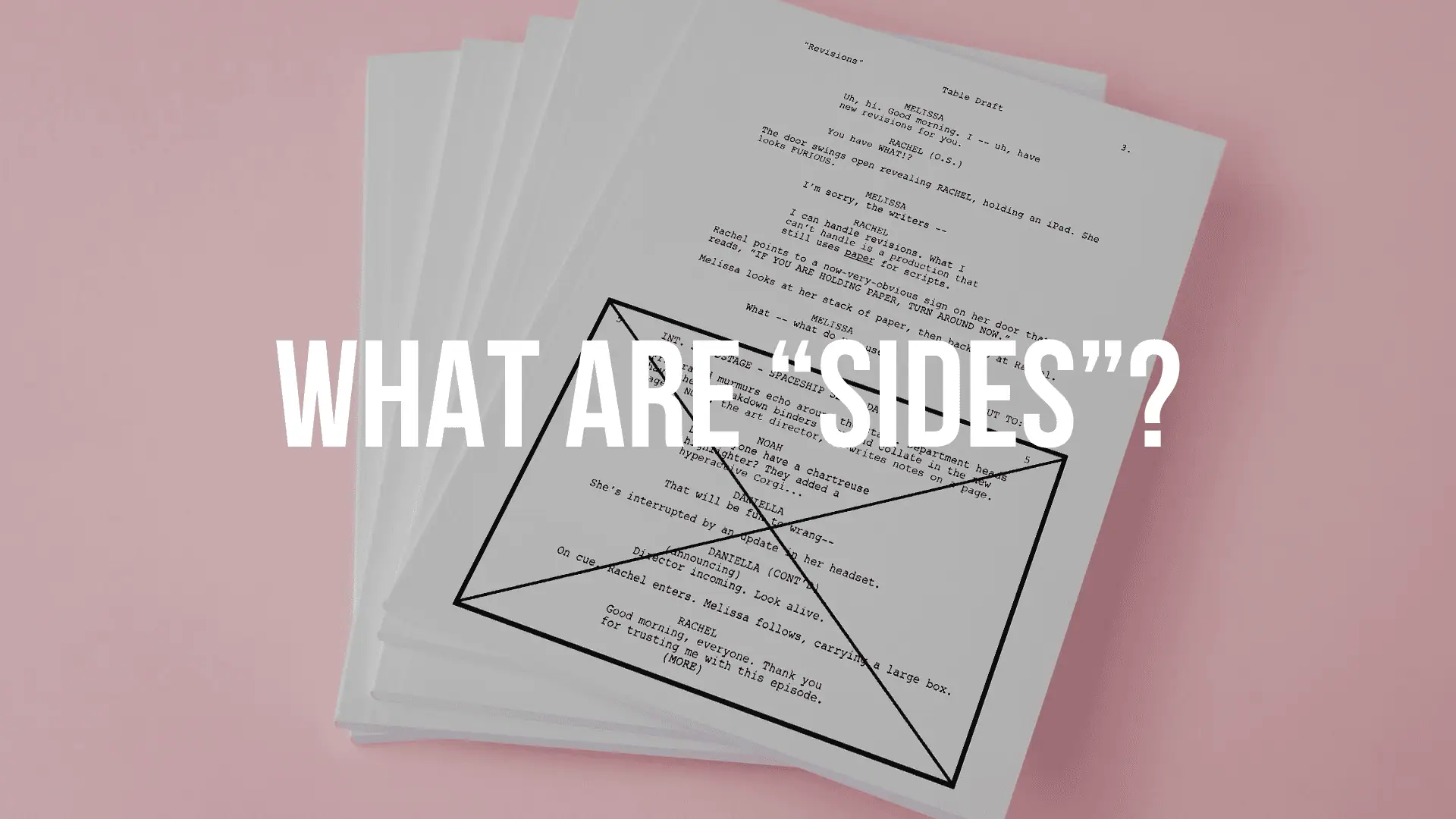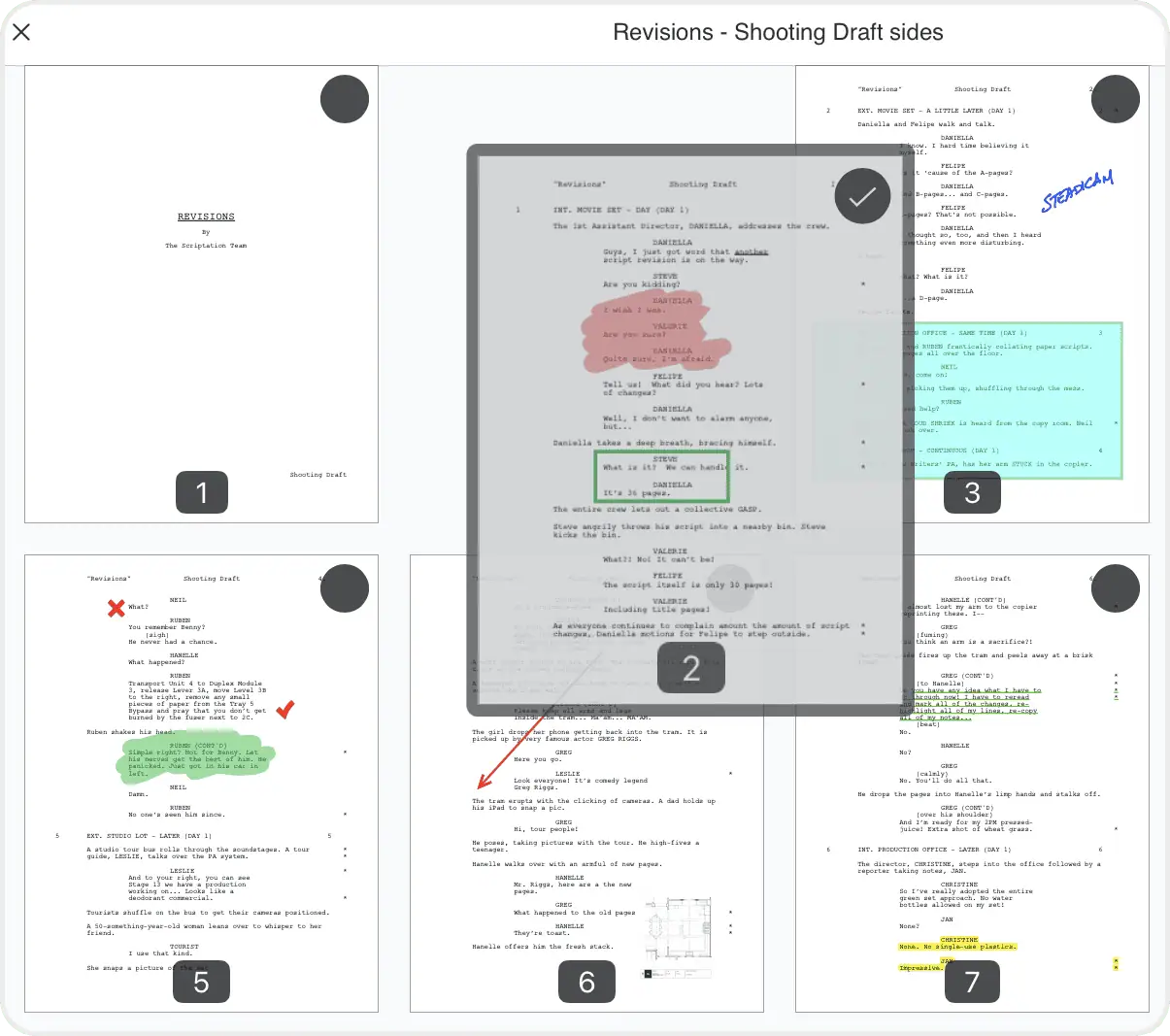
What are Script “Sides” in Film and Television?
Your first day on a film or TV set, there’s a lot of new things thrown in your face both verbally and sometimes, physically. Call sheets. “Cast is flying in!” Prelim call sheets. “Back to one?” Where do the writers sit? “Turning around!” Did someone just call that grown man a ‘Best Boy’? As you try to navigate the world of production, there’s one tool that no one can survive set without: sides.
Sides, a collection of the scenes being shot on any given day of production, are a lifeline to any crew member. They’re depended on by actors, directors, writers, producers, cinematographers… basically anyone who wants to follow along with the work of the day.
There’s almost as many uses for sides on a set as there are people who use them; and whether your sides are primarily a script, map, notepad, or messy combination of the three, using sides to their full potential will only make your end product better. Here are just some of the ways one can define (and use) your sides:
PRODUCTION SIDES
I think I get it — sides are just small scripts?
Think of them as excerpts. Sides take the scenes from the script that are shooting that day, list them in shooting order, and lose the rest.
For example, if you were shooting scenes 1, 3, and 15, they’d contain only those scenes (often in the order they’re scheduled to be shot, not numerically). This is easier than everyone having to carry around full paper scripts, or searching through digital files to find the latest version of a specific scene (which, let’s be honest, we’ve all been a draft behind at a meeting at one point or another).
Sides also come with the first page of the Call Sheet, serving as both a Table of Contents and a Title Page. Now you now only know what’s filming, but where (locations), with who (cast, background, stunts), and what (props, set dressing, etc.).
SIDES FOR ACTORS
What about “Actor Sides”?
Sure. They’re sometimes called “actor sides“, for a variety of reasons related to how they’re used.
The most common refers to how actors will use them for rehearsing a scene during a shoot. The first rehearsal of any scene has the actors read it aloud while the director, writers & producers, and cinematographer listen along. This is usually the first time writers will hear anything rewritten after the Table Read, so they’re making sure everything sounds right, sounds funny (for comedy), and is in the voice of the characters.
This is a great time for actors to collaborate with the creatives on anything they might bump on, so writers have time to revise ahead of shooting (since rehearsals are done before lighting, giving everyone time to change hair and makeup or get new pages written and approved by the Showrunner).
If the script has been locked for a while, this rehearsal period is still a chance for everyone to see the scene on it’s feet, as the Director will then do a blocking rehearsal where they walk the actors through their movement/locations in a scene. This is vital for the cinematographer, who will then be able to relay the movement to his camera and lighting teams so everyone will be prepared for what’s going to happen during the scene.
Whether crew are using hard or digital copies, everyone is *literally* on the same page.
SIDES FOR AUDITIONS
What other ways can actors use sides?
“Audition sides” refer to the scenes from a script meant to be read in the audition. The casting directors will send these scenes out for actors they want to audition for a new role in a given project — but without the call sheet cover page.
The actors will take these audition sides and prep for the audition. If it’s a self tape, the actor will read, rehearse, and record themselves doing the scene and send it in to the casting directors; instead of driving over to the casting office to read in person.
With Scriptation Rehearse, you can do all your audition prep in one easy-to-use app, so you can focus on the craft, and less on the logistics.
TV SIDES
Are sides the same on movies as TV?
The only difference between “TV sides” and “movie sides” is the size of the script they come from.
Well, besides the security surrounding them. Spoilers for say, an episode of the next season of “It’s Always Sunny in Philadelphia” wouldn’t be under as tight a lock and key as sides for “Avengers: Doomsday“.
FEATURE SIDES
How do TV and film writers use sides?
For writers, sides reflect a script you know better than anyone else on set. Now that the rest of the cast and crew have that script, sides are indispensable when it comes to how you shoot it.
A writer will use the sides to track how the scene is going during filming; takes they liked, jokes they know you hit (and don’t need to get another take of), or any notes you might want to have for a later scene/episode/edit bay session.
You can also scratch out an ALT (short for ‘alternative line‘) for dialogue that’s not working, or one you wanted to get an extra look at in a different tone.
Basically, if the produced scene is the canvas, the sides are your palette.
If a line isn’t flowing perfectly as it did in the writer’s head (or an actor is having trouble pronouncing a specific word or phrase), the writer will refer to their sides to find a solution. Once they’ve made their edits, they’ll confer with the Script Supervisor over what’s changing before giving the actor the revised material.
SIDES FOR FILMMAKERS
Where can I get sides?
Sides are traditionally e-mailed out to cast and crew as a PDF by the production office, and available on set as hard copies (for the less-spoiler obsessed production). If you’re looking for ways to enhance your workflow, try sides with the Scriptation app, your go-to script annotation tool.
Scriptation allows for the use of digital sides either from opening the production’s digital script distribution, or with custom ones you can make yourself with the Scriptation Page Maker (available with an Industry Pro subscription).
When using sides in Scriptation, you never have to worry about losing your paper script. Many a TV writer has seen their paper sides disappear during a location change, lunch, or bathroom break; or littered across the floor of their cars after wrap. Scriptation’s sides also allow for adding pages for notes, storyboards, ALT pages, or any other custom material you want to have easily accessible on your tablet or mobile device.
Best of all? Scriptation sides are a lot easier than lugging a binder around set all day.


